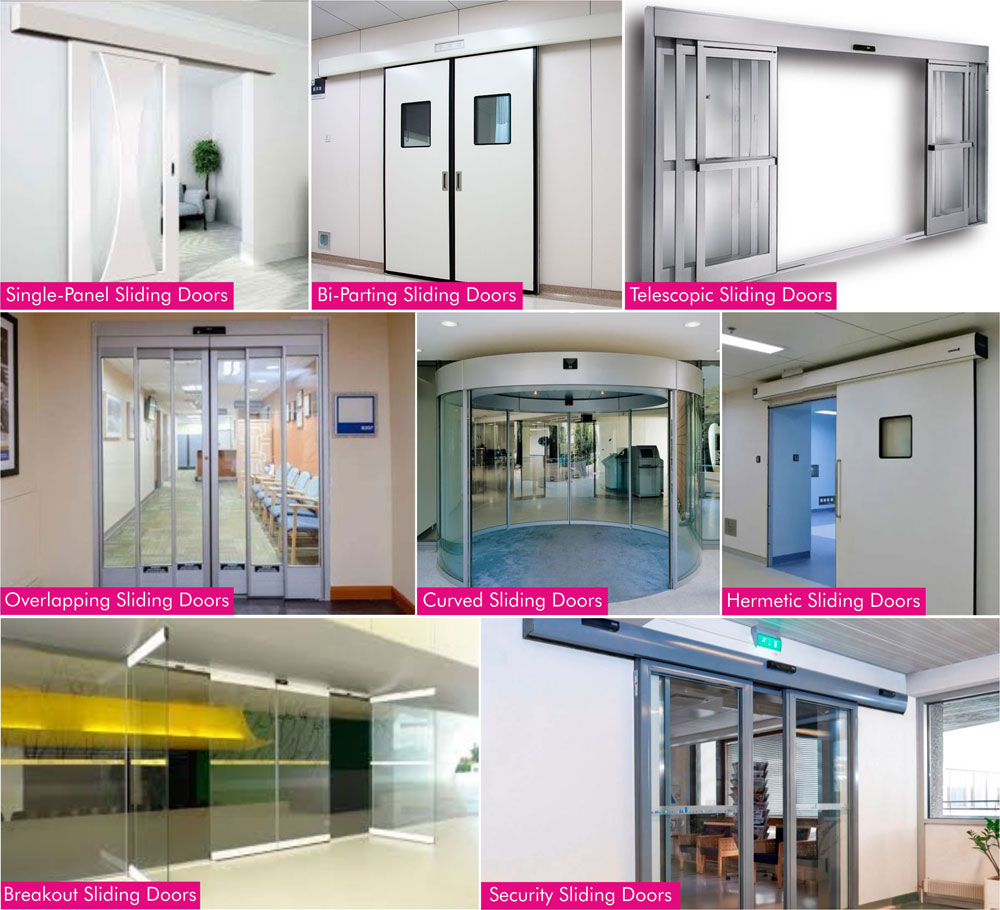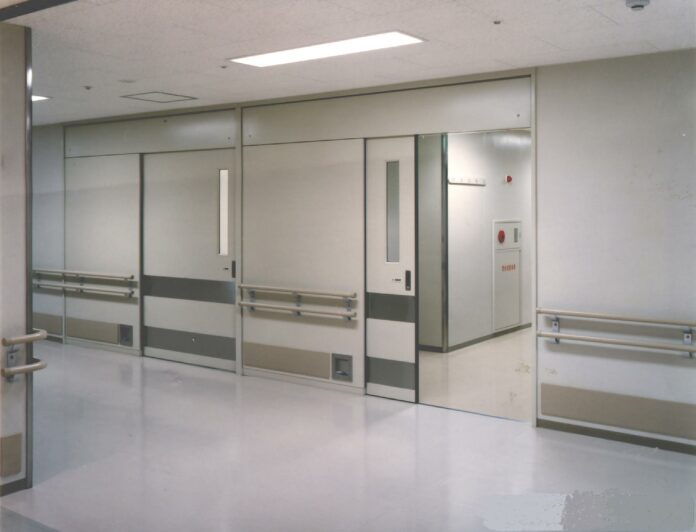Automatic sliding doors are a type of door system that open and close automatically, typically operated by sensors, motion detectors, or push buttons.The automatic sliding doors consist of panels or sections that slide horizontally along a track, allowing people to enter or exit without the need to manually push or pull the door. These doors are equipped with various sensors and mechanisms that detect the presence of individuals approaching the door and initiate the opening process. They can also be connected to access control systems, CCTV surveillance, or building management systems, allowing seamless integration and centralized control.Automatic sliding doors are manufactured using glass, aluminum, stainless steel, fibreglass composites etc. These types of doors are commonly used in shopping malls, hospitals, airports, office buildings, hotels, retail stores etc.
Automatic sliding doors provide convenience and improve the flow of people in high-traffic areas. They open and close quickly, allowing for smooth and efficient movement, particularly during peak periods. These doors also contribute to energy efficiency by minimizing the exchange of conditioned air between the interior and exterior of a building. They open and close swiftly, reducing the amount of time the door remains open, thus preventing the unnecessary loss of heated or cooled air. This can lead to energy savings and improved environmental sustainability.

Components of automatic sliding doors
Automatic sliding doors consist of several components that work together to ensure smooth and efficient operation. Here are the key components typically found in an automatic sliding door system:
1. Door Panels: The door panels are the moving parts of the sliding door that open and close to allow entry and exit. They are usually made of glass or other transparent materials to provide visibility.
2. Door Track: The door track is a channel or rail system mounted above or below the doorway. It guides the movement of the door panels and ensures they slide smoothly and securely.
3. Drive Mechanism: The drive mechanism is responsible for opening and closing the door panels. It can be powered by an electric motor, pneumatic system, or hydraulic system. The drive mechanism may include gears, belts, or chains to transfer the motor’s power to the door panels.
4. Motion Sensors: Motion sensors detect the presence of people or objects approaching the door. These sensors are usually mounted near the entrance and send signals to the control system to initiate the door opening process.
5. Control System: The control system manages the overall operation of the automatic sliding door. It receives input from the motion sensors and other devices, processes the signals, and sends commands to the drive mechanism to open or close the door.
6. Safety Sensors: Safety sensors are an essential component of automatic sliding doors to prevent accidents and ensure user safety. These sensors can include infrared sensors, safety mats, or photoelectric beams that detect obstructions in the door’s path. If an obstruction is detected, the sensors signal the control system to stop or reverse the door’s movement.
7. Activation Devices: Activation devices are used by individuals to initiate the door’s opening process manually. These devices can include push buttons, touchpads, or proximity sensors. They provide a convenient way for users to open the door when needed.
8. Emergency Breakout: Some automatic sliding doors are equipped with an emergency breakout feature. In case of an emergency or power failure, this feature allows users to manually push or slide the door panels to open and evacuate the building.
9. Safety Signage and Indicators: To ensure user awareness and compliance with safety measures, automatic sliding doors often have safety signage and indicators. These can include caution signs, directional arrows, and indicators that display the door’s status (open or closed).
It’s important to note that the specific components and technologies used in automatic sliding doors can vary depending on the manufacturer, door size, intended application, and local building codes.

Advantages of automatic sliding doors
Automatic sliding doors offer several advantages that enhance their functionality, convenience, and safety.
- Equipped with motion sensors that detect the presence of individuals approaching the door. These sensors trigger the door to open when someone is within a certain range, eliminating the need for physical contact or the use of activation devices.
- Comes with various activation devices for user interaction. These devices include push buttons, touchless sensors, keycard readers, or access control systems. They provide an alternative method to trigger the door’s opening and closing.
- Features adjustable opening speeds. The speed can be programmed to accommodate the traffic flow and specific requirements of the location. Slower speeds may be preferred in areas with high foot traffic or for increased safety.
- Allow for the adjustment of the closing force. This feature ensures that the doors close firmly but not too forcefully, preventing accidents or injuries caused by excessive force.
- Prevents collisions, automatic sliding doors incorporate safety sensors. These sensors detect objects or obstructions in the door’s path and prevent the door from closing or activate an immediate reversal of motion. Safety sensors can include infrared sensors, microwave sensors, or laser sensors.
- Equipped with emergency breakout functionality. In the event of a power failure or emergency situation, these doors can be manually pushed or pulled to open, providing an emergency exit or allowing manual operation when necessary.
- Can include programmable timers to control their operation based on specific time intervals. This feature can be useful for energy conservation by adjusting the door’s opening and closing times during periods of low traffic or after business hours.
- Attached with the hold-open feature that allows the door to remain open for an extended period. This can help accommodate large groups of people, facilitate the movement of furniture or equipment, or create an open flow between adjacent spaces.
- Can be integrated with access control systems, such as card readers or biometric scanners, to restrict entry to authorised personnel. This feature enhances security and ensures controlled access to the premises.
- Can be operated remotely using wireless controls or mobile applications. This feature allows for convenient operation and control from a distance, particularly in situations where manual interaction with the door is impractical or challenging.
Types of automatic sliding doors
There are several types of automatic sliding doors available, each designed to suit different architectural and functional requirements. Here are some common types of automatic sliding doors.
Single-Panel Sliding Doors: This type of automatic sliding door consists of a single large panel that slides horizontally to open and close. It is suitable for smaller entrances and areas with limited space.
Bi-Parting Sliding Doors: Bi-parting automatic sliding doors consist of two panels that slide apart simultaneously, creating a wide opening. These doors are commonly used in areas with high traffic or where a larger entrance is required.
Telescopic Sliding Doors: Telescopic automatic sliding doors have multiple narrow panels that slide together in a telescoping manner when opening. This design allows for a wider opening while using less wall space compared to bi-parting doors. Telescopic doors are often used in areas with limited wall space or when maximizing the clear opening width is a priority.
Overlapping Sliding Doors: Overlapping automatic sliding doors are similar to telescopic doors but have panels that overlap when opening. This design provides a larger clear opening width and can be suitable for areas with limited wall space.
Curved Sliding Doors: Curved automatic sliding doors are designed with curved panels that follow a curved track, allowing them to conform to architectural curves or create a visually appealing entrance. These doors are commonly used in buildings with curved facades or design elements.
Hermetic Sliding Doors: Hermetic automatic sliding doors are specialized doors commonly used in healthcare facilities, laboratories, or cleanrooms. They are designed to provide airtight sealing when closed, preventing the transfer of contaminants or maintaining controlled environments.
Breakout Sliding Doors: Breakout automatic sliding doors feature panels that can be manually pushed or pulled to open in case of emergencies or power failures. This allows for quick and easy evacuation or manual operation when needed.
Security Sliding Doors: Security automatic sliding doors are designed with reinforced panels, advanced locking systems, and integrated access control features to enhance security. These doors are commonly used in high-security facilities, banks, or sensitive areas where access control and protection against unauthorized entry are crucial.

Applications of automatic sliding doors
Automatic sliding doors are widely used in various applications due to their convenience, accessibility, and efficient operation. Here are some common applications of automatic sliding doors:
- Commercial Buildings: Automatic sliding doors are extensively used in commercial buildings such as office complexes, retail stores, malls, and restaurants. They provide a welcoming entrance, ease of access for customers, and efficient traffic flow management in high-traffic areas.
- Hospitals and Healthcare Facilities: Automatic sliding doors are crucial in healthcare settings for their ability to facilitate easy and hygienic movement of patients, medical staff, and equipment. They are used in hospital entrances, patient rooms, operating theaters, emergency departments, and other areas where hands-free operation is essential.
- Airports and Transportation Hubs: Automatic sliding doors play a vital role in airports and transportation hubs, ensuring smooth and efficient passenger flow. They are used at entranceways, security checkpoints, boarding gates, and baggage claim areas, providing convenient access while maintaining security measures.
- Hotels and Hospitality: Automatic sliding doors are commonly found in hotels, resorts, and hospitality establishments. They offer a welcoming entrance for guests, allowing for easy movement with luggage and providing a seamless transition between indoor and outdoor spaces.
- Retail Stores: Automatic sliding doors are extensively used in retail stores, supermarkets, and shopping centres. They create an inviting entrance for shoppers, enable easy entry and exit with shopping carts or strollers, and contribute to a pleasant shopping experience.
- Educational Institutions: Automatic sliding doors find applications in schools, colleges, and universities. They provide accessibility for students, staff, and visitors, allowing for smooth entry and exit during busy periods, such as class changes or events.
- Public Buildings and Facilities: Automatic sliding doors are utilized in various public buildings, including government offices, museums, libraries, and cultural centers. They enhance accessibility, accommodate diverse user needs, and contribute to the overall ease of use.
- Industrial Facilities: Automatic sliding doors are used in industrial facilities, warehouses, and factories to facilitate the movement of goods, vehicles, and personnel. They can be customised for larger openings, accommodate forklift traffic, and enhance productivity in logistics operations.
- Public Facilities and Institutions: Automatic sliding doors are used in various public facilities such as libraries, community centres, museums, and government buildings. They improve accessibility, provide easy entry and exit for visitors, and contribute to a welcoming environment.
- Residential Buildings: Automatic sliding doors are occasionally installed in high-end residential buildings, luxury homes, or properties requiring accessibility features. They can provide a grand entrance, offer convenience for residents, and improve the overall aesthetic appeal.
These are just a few examples of the broad range of applications where automatic sliding doors are utilised. The convenience, accessibility, and safety features of these doors make them a popular choice in many public, commercial, and institutional facilities.
Conclusion
The demand of automatic sliding doors continues to grow and evolve as technology advances and the demand for convenient and accessible entrance solutions increases. Automatic sliding doors are being integrated into broader building management systems and smart building solutions. These integrated systems can control and monitor various aspects of a building’s operations. Automatic sliding doors are now available in a wide range of designs, finishes, and customizable options. This allows architects and designers to integrate automatic doors seamlessly into the overall aesthetics and design theme of a building. The trend of automatic sliding doors aligns with the broader advancements in technology and the increasing focus on convenience, safety, sustainability, and seamless integration within the built environment.

